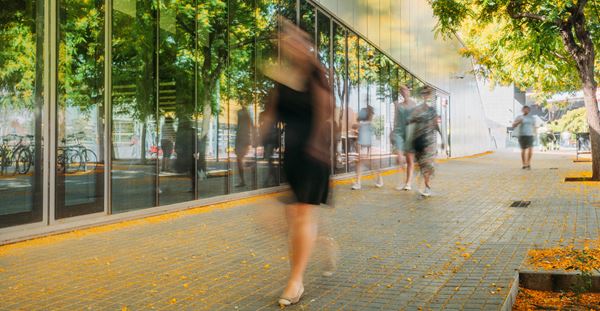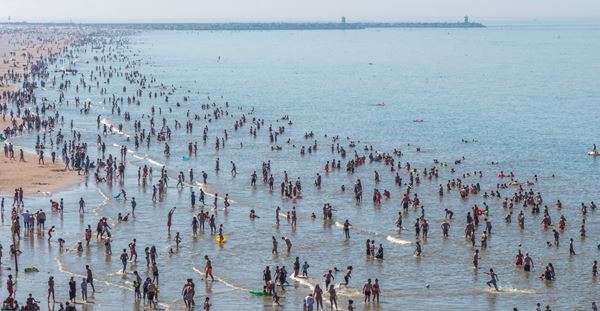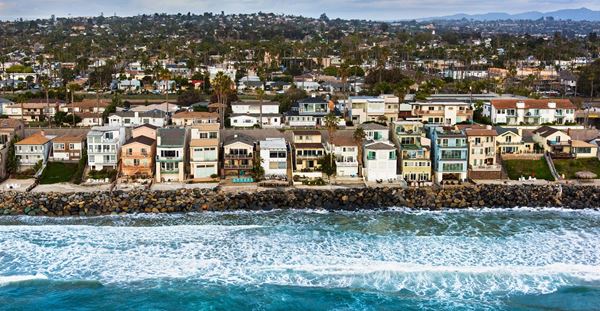2024 is now the hottest year on record, and it’s not just a statistic; it’s a wake-up call. With rapidly rising temperatures, cities, industries and businesses around the world are being pushed into an era where extreme heat is a defining challenge of our time.
Today, we’re witnessing heat waves that stretch beyond summer months, wildfires that devastate communities, and droughts that cripple economies. Once anomalies, these have become a regular feature of life in cities and communities worldwide. What was once considered a 1-in-100-year event, like the 2003 heatwave in Southern Europe, is becoming more frequent. By 2040, such devastating heat events could occur every other year1, forcing cities and governments to rethink resilience strategies and infrastructure at a fundamental level.
Cites are widely seen as central to the climate crisis with urban areas seen as islands that trap and radiate heat. And they also now serving as home to more than half the world’s population. Research released in September 2024 shows that nearly two-thirds of the global public feel personally affected by climate change experience it through extreme heat2. By the turn of the century, heatwaves could affect 75% of the global population3, with economic losses reaching $23 trillion by 20504. But this is not just about projections. It’s about the human experience - a human crisis, driven primarily by human-induced climate change5.
The heat is on. And the need for proactive planning and resilient infrastructure is more urgent than ever. Is your city or business prepared for this increasingly hotter world?
The Future is Here - Hotter Days Ahead
Extreme heat is not a distant issue; we see and feel its impact in our everyday lives as temperatures continue to rise. From intensified turbulence and infrastructure breaks - like this summer when extreme heat caused the metal of New York’s Third Avenue Bridge to expand, leaving it stuck open for hours,6 - to its effects on worker productivity and the health of our communities. Globally, it’s the deadliest weather-related hazard, responsible for 489,000 deaths per year since 20007, about 30 times more than tropical cyclones and hurricanes8.
Communities that were once resilient to heat are now more vulnerable than ever to its impacts. People at elevated health risk from extreme heat exposure fall into three categories: those with increased exposure, increased biological sensitivity, and/or those who face high socioeconomic burdens. In the U.S., almost one in four people fall into these categories9, which include emergency responders, athletes, workers without sufficient cooling, those experiencing homelessness, children and adults over 65, pregnant women, and individuals with chronic health conditions.

This further compounds for people with socioeconomic burdens such as low income or living in a low resource community, as they are often least equipped financially and infrastructurally to cope with heat increases. And as temperatures rise and extreme heat events increase in frequency and intensity, even the healthiest of populations will face risk of direct heat related illness. It will impact everyone.
Urban environments are at the epicenter, amplifying this crisis.

The Urban Heat Island (UHI) effect causes cities to be significantly hotter than surrounding and rural areas, as heat-absorbing surfaces like pavement and buildings trap and radiate warmth, a phenomenon that intensifies during heatwaves. Extreme heat events can also increase the amount of heat dispersion from buildings to the urban environment by up to 20%, largely in the form of heat waste from air conditioning 11. This makes it critical for urban planners, real estate developers and governments to consider energy efficient and green infrastructure solutions supported by holistic, long-term capital planning and strategies.
Heating Up: Supply Chains and Productivity

Beyond its impact on communities, extreme heat will increasingly disrupt integrated global supply chains and economies. While physical climate hazards like floods, wildfires and sea level rise pose significant risks to business operations, heat stress threatens a large portion of assets across all sectors globally. A recent Moody’s ESG solutions report identified utilities and manufacturing as most at risk, followed closely by transportation and warehousing, which face high exposure to this very real, growing challenge12.
Extreme heat resilience in action: In Australia, Arcadis is using modeling tools to assess how heat affects road longevity and integrate this data into the early stages of infrastructure design. This analyzes the albedo effect, which measures how much heat is reflected by impervious surfaces like roofs and roads, and can be a key factor in creating more resilient infrastructure to withstand the effects of rising temperatures.
-
Read more
Extreme heat related disruptions to supply chains also pose significant consequences to global food security, energy supply and the supply of manufacturing materials13. Beyond assets, there’s a loss of productivity. In the U.S. alone, heat already causes $100 billion in productivity losses each year - a figure that is expected to rise to $500 billion by 205014. And, in the EU and UK, a 1°C rise above 25°C results in an annualized sales loss of $614 million15.
Extreme heat is rapidly becoming one of the most dangerous threats to both human health and economic stability.

While the economic cost of inaction is staggering, loss of productivity directly relates to human health and wellbeing. The risk of extreme heat to outdoor workers, such as mail carriers, delivery drivers, agricultural workers, and informal workers, particularly those in developing economies, as well as those working in environments without air conditioning, including online retail warehouses, commercial kitchens, and power plants is significant. Lost worktime often means lost wages which increases social vulnerability.
Taking action on extreme heat is a solution that promotes both economic and health equity while addressing the climate crisis. At Arcadis, we recognize this and are focused on providing leading innovative strategies to address extreme heat now and in the future. With deep knowledge across multiple sectors, we focus on guiding decision making to ensure our clients and communities adapt and thrive as our environments heat up.
Extreme heat resilience in action: Cities like Washington D.C. are taking the lead with ‘cool corridors’ aimed at providing shaded walkways and cooling zones for vulnerable populations. These corridors serve those most at risk, such as the elderly and those without access to air conditioning, but they also provide a blueprint for cities around the world to follow.
Under the Canopy of Shade – The Power of Passive Cooling and Nature Based Solutions
As we adapt to this new climate reality, air conditioning can save lives. And, while it currently accounts for 7% of the world’s electricity, and nearly 20% of the electricity used in buildings globally16, many homes in hot countries have yet to install their first air conditioner. Further, sales of lifesaving AC units expected to triple globally by 205017.
But it’s a double-edged solution. 2022 estimates indicate that air conditioners and their refrigerants contributed to 3.7% of total GHG emissions18. Staying cool is making it hotter.
Adaptation cannot rely on energy-intensive mechanical cooling alone. In communities where air conditioning is not an affordable or reliable option extreme heat is even more deadly. Passive cooling, the process and techniques to cool spaces without the use of energy, has the potential to reduce load on air conditioning by as much as 80%19 and can be key to surviving extreme heat both indoors and out.
-
Read more
Natural solutions like planting trees, creating green spaces, and simple design and retrofitting opportunities like reflective surfaces, thermal insulation and natural ventilation, are also essential tools to sustainably and affordably address the dangers of extreme heat. Urban forests are one such example that are growing in importance. In Paris, efforts to increase urban tree cover are proving successful in reducing the heat impact in the city. These solutions cool the environment and create co-benefits such as improved air quality, better biodiversity, and stronger communities. As cities continue to look to gain every degree of coolness, these passive solutions are not just nice to have - they are critical for survival.
Extreme heat resilience in action: The city of Newark, New Jersey, one of the fastest heating cities in the US, has embarked on a plan to plant one million trees to create more shaded, cooler environments. But these long-term strategies take time, and interim solutions like temporary shade structures, reflective pavements, and cool roofs are crucial to managing the heat in the short term. Arcadis is partnering with the city’s Office of Sustainability to pursue an extreme heat strategy and interventions across the city.
As Nicole Hewitt-Cabral, Chief Sustainability Officer City of Newark shares, “Residents of Newark are feeling the heat - literally. With increasing heatwaves and minimal tree canopy, especially at bus stops, it’s becoming harder to commute, enjoy outdoor activities, or connect in green spaces. The city is seeing more code red alerts than ever, and relief is limited without more shade. But Newark isn’t just sitting back. The city is committed to building a vibrant urban canopy by planting thousands of trees, constructing cool bus shelters, and incorporating energy-efficient buildings with retroreflective surfaces. It’s going to take everyone pitching in - time to roll up our sleeves and get our hands a little dirty.”
Passive cooling solutions often fall under the category of nature-based solutions like blue and green infrastructure. Rain gardens, bioswales, and water features provide natural cooling while enhancing biodiversity and managing stormwater, improving the build environment to directly provide benefits to residents.
Arcadis has also been working with cities like The Hague in the Netherlands to transform public spaces, such as libraries, into cooling centers that also serve as resilience hubs. These spaces are more than just shelters from the heat; they foster community resilience during extreme weather events.
Technological innovation is also key. Tools like Tygron, a mapping software used by Arcadis, create digital twins of cities, enabling planners to identify heat hotspots and design targeted interventions. AI-driven tools continue to advance rapidly and can be effective in predictability and decision-making, such as Google's heat exposure mapping that can help cities model the effects of cool roofs and tree canopies on thermal comfort.
Preparing for a Hotter Future – Where Can You Start?
While we cannot reverse the global rise in temperatures, we can mitigate its impact with proactive, integrated, and innovative strategies. Extreme heat is a global crisis that demands a coordinated response. Governments, businesses, and communities must come together to implement adaptive measures that will not only protect populations but also safeguard economies and critical infrastructure.
The Heat Will Continue – But So Can Our Innovation
As the biggest contributors to its worst effect, is within our power, as cities, businesses and industries, to lessen the impacts of heat. A combination of innovative technologies, data-driven strategies, and community-driven solutions can ensure that our cities remain livable and resilient in the face of this challenge.
The tools, technology, and strategies are at our fingertips. The choice we face is clear: we can either act now to create a future where heat adaptation is embedded into every aspect of urban living, or we can continue to pay the price as temperatures continue to rise. Now is the time to make decisions that will ensure resilience and prosperity for future generations.

Climate Change: The Urgent Crossroad Shaping Our Future
Discover how we can redefine climate solutions with bold actions in the first article of our Future of Climate series
Sources
1. Nature Communications: Rapid increase in the risk of heat-related mortality
2. Insight of the Week (globescan.com)
3. National Geographic
4. The New York Times: Climate change could cut world economy by $23 trillion in 2050
5. Sixth Assessment Report - IPCC
6. News 12
7. U.N. Reference in Scientific American
8. UN Secretary General
9. United States Census Bureau
10. US Department of Health and Human Services
11. US Department of Energy: Office of Science
12. Moody’s
13. Nature.com: Global supply chains amplify economic costs of future extreme heat risk
14. Adrienne Arsht-Rockefeller Foundation Resilience Center
15. The Conversation
16. Our World in Data
17. IEA: The future of Cooling
18. Oxford Academic
19. Science Direct






